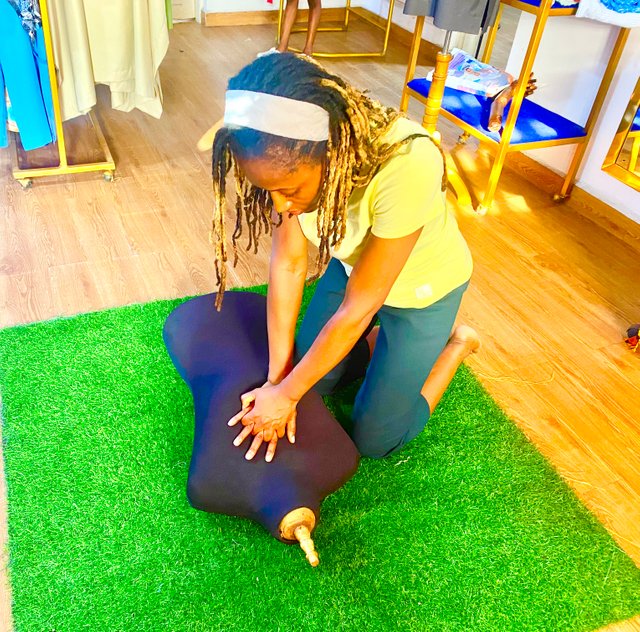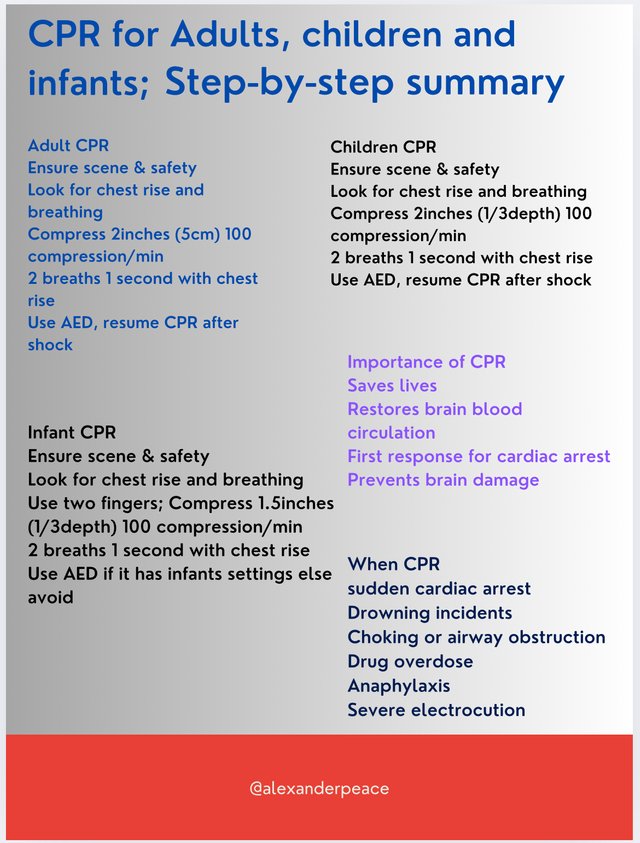Greetings and welcome to my blog. Am excited to be a part of another exciting class. Thank you teacher for the elaborate lecture and your determination to make us good first responders.
Perform all steps of cpr on a mannequin (your productivity) and explain each and every step in detail. Teach CPR to only 3 people (may it be your family, friends, relatives, or fellow mates and attach pictures of you teaching them) |
|---|

(Note: My mannequin is plastic hence chest compressions are not very visible to avoid breaking it)
CPR is an important life saving medical procedure and should be done accurately to ensure its effectiveness.
Before I start my CPR procedure in any case, I must remember my DRABC protocol taught in the previous module. My safely comes first. Below are the standard steps to CPR.
STEPS TO CPR (cardiopulmonary resuscitation)
Step 1: Scene assessment and responsive check:
I must ensure that the scene is safe first and then shake the victim gently and shout “Are you ok?”. Then I would proceed to call for help by asking someone in the mob to call for the emergency services and also get an AED as soon as possible.
Step 2: Check breathing:
Using the LLF protocol for about 10 seconds, I would look out for chest rise and breathing. If the person is not breathing normally or is gasping, I would start CPR.
Step 3: Chest compressions:

- Placement of hand and knee: I would kneel down right lateral to the victim. I would place my hand on the other interlocking my fingers while placing the heel of my hand on the middle of the chest on the lower half of the breast bone. The perpendicular position attained by my legs on the ground and on the victims chest would enable me not to get tired easily.
- Depth and rate: I would compress the chest about 5cm at 100-120 compression per minute. I would count out loud as this would help to boost my energy and make for effective counting.
Step 4: Open airway:
I would proceed to do the head-tilt and chin-lift maneuver to open the airway.
Step 5: Provide rescue breaths:
- With the mouth in a tilted position, I would pinch the nose tightly and initiate a seal over the mouth and ensure that the air I breath into the mouth is not lost through the openings.
- I will give two breaths with chest rise 1 second each.
- I would continue 30 compressions (2 breath cycles) until AED or help is available. If am not comfortable with giving breaths, I could do hand only CPR or use AMBULANCE bags if they are available.
Step 6: AED usage:
- I would turn on the AED (Automated External Defibrillator ) and follow the prompts.
- I would proceed to place pass on the chest on the lower side of the right collarbone.
- I would ensure that during the analysis and shock, that no one is touching the victim.
- After the shock, I would resume CPR.
 |
|---|
How to perform CPR on pregnant lady, obese people and weak elder people, write modifiable procedures for each in detail. |
|---|
CPR on a pregnant woman
Scene assessment and responsive check:
My safety comes first hence I have to access the situation and ensure it’s safe. I would call and ask if she’s ok and proceed to ask someone to call for medical emergency help.
Check breathing: I would lay her in a supine position and Check for breathing using LL F protocol and look for chest rising and breathing. If she’s gasping for breath I would proceed with CPR.
Chest compressions: Before I start my chest compressions, I would have to check for any possible signs that shows that she’s not in the state for compressions. For example, if fluid is coming out of her mouth but she’s not choking, it could mean that there’s an obstruction hence I would have to do initial ventilation for her before starting Compressions. I would have to roll her on her side and give her five blows on the back and five abdominal thrusts before starting the CPR and giving her breath if I can.
If she’s not breathing, I would do chest compression 100-120/minute, pressing 2 inches adjusting my hands slightly to the left side of the sternum and continue until AED or help is available or until she recovers.
AED usage: AED has no effect on pregnant women hence can be used on them and then CPR Should be continued after shock until EMS arrives.
CPR on an Obese person
Scene assessment and responsive check:
I must first ensure that the scene is save. I would call on the victim and shout “Are you ok?”. Then I would proceed to call for help by asking someone in the mob to call for the emergency services and also get an AED as soon as possible.
Check breathing:
Using the LLF protocol for about 10 seconds, I would look out for chest rise and breathing. If the person is not breathing normally or is gasping, I would start CPR.
Chest compressions:
I would proceed with the regular chest compressions. I would compress the chest about 5cm at 100-120 compression per minute. I would count out loud as this would help to boost my energy and make for effective counting.
Because of the body mass of the person, I would have to apply more pressure and chest compressions would have to be deeper in order to be effective and the first responder may get tired easily hence should allow someone else continue when tired.
Open airway:
I would proceed to do the head-tilt and chin-lift maneuver to open the airway.
Provide rescue breaths: I will give two breaths with chest rise 1 second each. I would continue 30 compressions (2 breath cycles) until AED or help is available.
AED usage:
I would turn on the AED (Automated External Defibrillator ) and follow the prompts. I would proceed to place pass on the chest on the lower side of the right collarbone. I would ensure that during the analysis and shock, that no one is touching the victim. After the shock, I would resume CPR until EMS comes.
CPR on a weak elder
Scene assessment and responsive check:
My safety comes first hence I have to access the situation and ensure it’s safe. I would call loudly and ask if he’s ok while gently approaching to avoid startling the elderly person and proceed to ask someone to call for medical emergency help.
Note that elderly people may respond slowly to calls due to hearing loss, or cognitive impairments hence I have to be patient.
Check breathing: I would proceed to check for breathing for about 10 seconds while checking for chest rise. Elderly people may have irregular, slower or shallower breathing due changes related to serious conditions or age. If unsure he’s breathing, proceed to CPR.
Performing Chest Compressions:
I would start the 100-120 compressions per minute 2inches while counting out loud and maintaining the correct rhythm.
I must be cautious to avoid excessive compression as their bones are more fragile and may be at at risk of getting fractures on their ribs. I should listen for any cracking sound or resistance that’s abnormal and ensure to adjust my technique putting into consideration the acquiescence of the chest wall and how the elder is built bodily
If they’re a DNR restriction, avoid CPR. This can be spotted through a hand band or a tattoo on a visible part of the body.
Open airway: Ensure the airways are not blocked and do to mouth if convenient else continue with the compression until medical help comes.
AED usage: AED can be used on the elderly person but I would ensure he’s not been touch during the shock. Continue CPR after shock.
Elderly people may take time to respond to resuscitation hence do not give up easily.
Write explanation for all the mistakes people do during CPR, as we highlighted in the class topic. |
|---|
From the lecture given, we see many common mistakes people make during CPR and they include:
- Not providing adequate compressions and not being able to press into the chest deeply. If this happens the CPR will not produce the desired results hence ensure to Press into the chest deeply and provide adequate compressions.
- Compressions should be performed at the speed of 100-120 compressions per minute but performing it too slow or too fast is a common CPR mistake. Ensure to follow timely rhythm for good results.
- Between compressions, the chest not being allowed to rise back up fully. Allow chest to fully rise and then proceed.
- Taken pauses too long or too often during the compressions. Taken too long or short pauses Would defeat the aim hence moderation is required.
- Positioning the hand wrongly either too low or too high from the center of the chest. This would not make for the right impact hence ensure to rightly position the hand at the center for maximum impact.
- Delivering the breaths too quickly or not properly sealing the mouth. This should be done timely for effective results and breaths should not be allowed to escape.
- By continuing CPR when tired and not letting another person take over the responsibility thereby causing the compressions to be weak. Allow someone else to take over when you are weak for better compressions and results.
- Using arm strength only for compression especially when the CPR is performed on an adult this makes for futile attempts. Must include other process of CPR.
- Not calling for emergency assistance and focusing on the CPR only. Ensure to call for help before starting the CPR process, readily aa medical help can go along way to save the victim.
- Performing CPR on a soft surface or on the bed. This will not yield maximum results. Hard surface are better preferably on the ground.
- Doing rescue breaths without knowing how to or when not comfortable with it. You must be comfortable with doing CPR and should master the techniques.
- Discontinuing with the CPR process when the victim shows minimal gasps or movement. When the victim shows movement, don’t stop, continue until help comes.
Plan a simple campaign to raise awareness about CPR in your community. Write down the main goal of your campaign, who you want to reach (your target audience), and key messages you want to share. Think about how you can spread the word (like using social media or holding a community event). Your plan should be clear and include a basic timeline showing when you will do each part of the campaign. (You only have to devise a working plan and not practically implement it.) |
|---|
Note: For a successful campaign, I would have to source for sponsors as this would enable me to raise more funds for a successful campaign and the sourcing for fund would start three months to the campaign date. The campaign budget, strategies and goals would be presented to potential sponsors for perusal. The campaign would be for a period pf 6 weeks.
Name of campaign:
Alexanderpeace’ grassroots awareness campaign on CPR.
Target audience:
To make the campaign effective, I would target varieties of prospective audiences like:
- People in the health sectors and care givers
- Teachers in schools and students in tertiary institutions
- Adult care centers
- Sporting organizations for men and women
- Community centers and organizations
- Parents and business men
- Adult clusters in the community from 18 years and above.
Key messages to share:
- Importance of CPR
- CPR steps on different categories of people such as pregnant women, adults, obesed people, elderly and infants.
- When CPR is needed and when it’s not
- Common mistakes people make in CPR
Strategies for the campaign:
My campaign plan is for a period of six weeks and would be carried out by;
Using social media for online and on air awareness. (1-6weeks) requiring about #300,000 equivalent of 1200 steem if one steem is #250.
On ground awareness using fliers, banners, posters, door to door awareness and one on one. (1-6 weeks and 4th week, will expand on this later) requiring about #250,000 equivalent of 1000 steem.
On ground trainings (5th-6th week) requiring about #300,000 equivalent of 1200 steem.
Social media and on air awareness:
Awareness goes a long way to make a meeeting successful hence I would employ the use of Facebook adverts, youtube paid adverts and influencers for the social media promotion.
The on air promo would be done using radio and television interview advertisement. These would run from the first week to the last week of the campaign. Daily and prolonged advertising creates more awareness for people who missed on certain days.
Ongorund awareness: This is categorized into two. The banners and posters would be printed and mounted in strategic points in the community beginning from the first week to the last week. They are going to be hanging throughout the campaign period.
On the fourth week before the on ground training, fliers and hand bills would be share for door to door and one on one awareness and street awareness.
On ground training commenses on the fifth week all through the sixth week. All the prospective audiences reached out to are to be a part of the trainings.
It has to sparse over a period of two weeks daily to enable people come in for the trainings on the day that suits them as all may not be able to gather in one day considering the various target audiences reached out to.
Refreshments would be made available for the participants as this would encourage more turn out. Information about refreshments and mini gift items available for participants would be included in the fliers for more responses.
The venue of the training but must a place that is conducive and is easily accessible from any part of the community. For this campaign to be carried out effectively about 850,000 Naira would be needed that equivalent of 3400 steem if one steem is 250 Naira. That’s why the sponsors would come in very handy.
Design a simple infographic (Illustration) that summarizing the basic steps of CPR for adults, children, and infants, including why CPR is important and list situations when CPR might be needed (like drowning or heart attacks). |
|---|

Thank you for reading through. I ask @ruthjoe, @jovita30 and @ngozi99 to join the learning challenge.
Student Name @alexanderpeace
Overall Grade 8/10
Plagiarism Check Pass
AI Use No
General Feedback
The student presented a strong understanding of CPR procedures and effectively adapted techniques for diverse populations. Their campaign plan and infographic demonstrated thoughtfulness and organization. Focusing on expanding technical details and enhancing visuals will further elevate their work. Overall, a commendable effort!
Regards
@abdu.navi03
Downvoting a post can decrease pending rewards and make it less visible. Common reasons:
Submit
Dear teacher,
I think you should be more lenient in your grading and considerations. Considering that I put in my time and effort of over 7 hours to ensure I do my best in this task. I really think I deserve better grading if just the attachment of pictures is the reason for grade reduction.
You are wondering why the students aren’t really responding to the homework, it’s because it’s too cumbersome, hence when a student’s genuinely puts in efforts into doing the tasks which you can see from reading through it, they should be encouraged through the grading so that they can do more instead of getting discouraged through poor grading after hours of work.
Downvoting a post can decrease pending rewards and make it less visible. Common reasons:
Submit
@tipu curate 2
;) Holisss...
--
This is a manual curation from the @tipU Curation Project.
Downvoting a post can decrease pending rewards and make it less visible. Common reasons:
Submit
Upvoted 👌 (Mana: 2/7) Get profit votes with @tipU :)
Downvoting a post can decrease pending rewards and make it less visible. Common reasons:
Submit